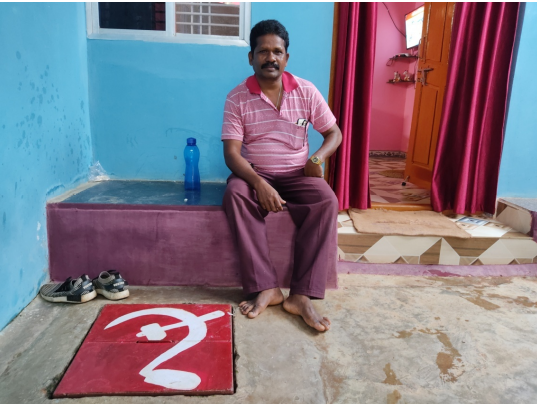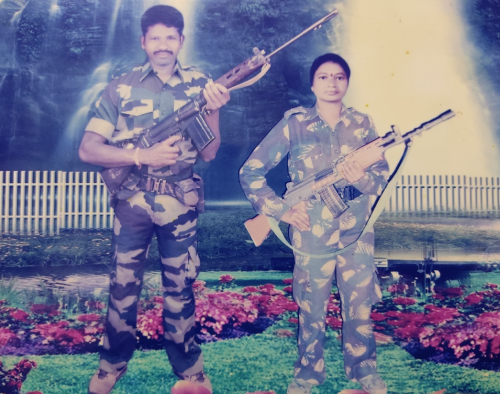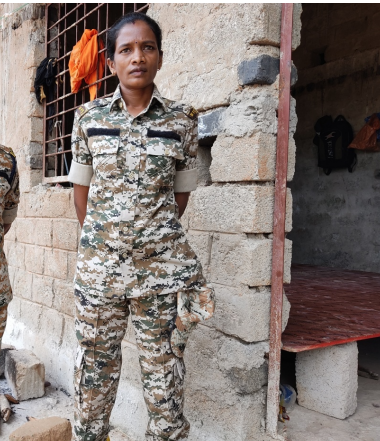‘Life in Maoist Belt Hinges on Barrel of Gun’

Ramesh Pudiyami, alias, Badaranna, former Maoist commander, Bastar.
Be it tribals, Maoists or the security forces, life in India’s scariest conflict zone hinges on the barrel of the gun, says Ramesh Pudiyami, alias Badaranna. Being Chhattisgarh’s first Maoist recruit and having spent a decade-and-a-half in the guerilla army of the Communist Party of India (Maoist), he is an eyewitness to Bastar’s violent life in the hilly terrains.
Born in Pamed village, in Bijapur district of undivided Madhya Pradesh, Badaranna joined the banned People’s War Group (PWG) at the age of 15 in late ’80s after witnessing the rampant exploitation of the Dorla tribe at hands of forest officials and contractors. “I belong to the Dorla community and my family and other villagers used to pluck tendu leaves (used to manufacture beedi). The contractors paid them a few paise per bundle of tendu leaves and frequently took away their goats and chickens. It became a routine affair with no one coming to our rescue,” he told Newsclick.
In 1984-87, Maoists often visited Pamed, which shared its border with Andhra Pradesh. Rebel squads frequently marched from Andhra’s Khammam district to Bijapur to create a safe base for the guerillas—and Badaranna’s unanticipated tryst with the nation’s deadliest guerilla rebels turned into a reality.
First, Badaranna was assigned to interact with the tribals and explain them the aims and ideals of Maoists. After 1992, the Dandakaranya Adivasi Kisan Mazdoor Sangh was formed as a front organisation. Forest officials and tendu contractors were targeted and forced to pay better wages to villagers, which ended the systematic exploitation. “It strengthened our hold on the villages, which started trusting the Maoists. It was a war to win the hearts of the tribals who were factual inheritors of the hills and forests,” said Badaranna.
Landlords and small businessmen were next. Wandering for a couple of years in the forests, Badaranna was tasked to for the Gram Rakshak Dal, which prompted the security forces to launch an offensive against the guerillas. After the formation of Sahakar Sangha through farming and continuous supply of seeds and safeguarding the wells and the ponds, the Maoists secured their grip on the tribals. Subsequently, Badaranna rose to become the local guerilla squad commander and ambushed the security forces in Bijapur (Basaguda and Bholapatnam) and Sukma districts.
Beyond physical tasks, ideological enhancement was mandatory by reading Marxist literature and participating in daily morning group discussions.

Badaranna with wife Latakka, alias Sushila.
In an interesting anecdote, Badaranna revealed that months before their surrender, he and his wife Latakka had a secret photo shoot against the organisation’s policy. The party, grappling with financial distress, decided to borrow dresses for its cadres from Velupillai Prabhakaran’s Liberation Tigers of Tamil Eelam which the couple can be seen wearing in the photo, hinting an episodic tactical give and take.
“Shouldering the responsibility of training new recruits started degenerating due to friction and internal conflicts. Being illiterate and yet assigned big responsibilities, I caused insecurity to the fresh entrants in PWG,” he said.
In January 2000, Badaranna and Latakka surrendered. Quitting the war wasn’t easy with the security forces pressuring him to turn an informer. When he resisted, Badaranna neither received the promised 5 acres nor the Rs 10,000 government job; instead, he was imprisoned for two years. After a legal battle that continued till 2008, the couple got employment and started leading a dignified life. Currently, Latakka is with the Chhattisgarh police force while Badaranna is a security guard of a park in Jagdalpur city. Despite quitting the violent life, his commitment to the Left ideology is visible in his eyes.
Maoists putting down guns in Bastar has a grey area as well with fake surrenders orchestrated to clean up state police’s image. Such official stunts result in human rights abuses and oppression of tribals. According to social activist Soni Sori, continuous intimidation of innocent tribals forced many indignant individuals to work indirectly or directly with the Maoists. In the history of Bastar, Sori has been one of the worst victims of physical abuse at hands of police and Central forces.
In January 2020, the Dantewada district police launched a campaign called Lon Varratu (which in local dialect means ‘Come Back Home’). As per official records, 403 Maoists, including many hard-core leaders carrying rewards on their heads, surrendered till last month. Under the initiative, the surrendered rebels have been rehabilitated, which also includes financial assistance.
One of the Maoists who surrendered is Sundari (37), who hails from Abhujmaad, Narayanpur district, another breeding place for insurgency. With a reward of Rs 8 lakh on her head, she had participated in deadly attacks on the security forces. After quitting the Maoist party in 2014, she serves the Chhattisgarh police force under the Lon Varratu campaign.

Surrendered Maoist member Sundari in Dantewada.
During her insurgency days, Sundari traversed dense forests, rivers and streams in the harsh summers and the chilling winters for miles with her guerilla battalion for more than a decade. In conversation with Newsclick, Sundari revealed that she was in charge of guarding the infamous senior Maoist leader Mandavi Hidma for three years. Hidma, the commander of Battalion 1 of the People’s Liberation Guerilla Army, was involved in Tadmetla attack on 76 CRPF personnel and the 2013 Jhiram Ghati attack, which wiped out the state Congress leadership. Sundari mentioned how targeting Hidma is extremely difficult due to the multilayered security rings around him.
Being a gunman and close to Hidma, Sundari’s inputs are an asset to the police. Besides toting an AK-47 on field, she has been busting the illusionary claims of the Maoist organisation by interacting with locals.
A teenage Sundari was identified by a woman cadre and picked up from home despite her family’s resistance. Due to her singing abilities, she was inducted into the Maoists’ cultural unit Chetna Natya Manch to highlight ‘state-sponsored brutality’ and the exploitation of villagers. An intriguing tactic came to the fore wherein Maoists interacted with schoolchildren and teenagers. In their areas of influence, the local population wittingly or unwittingly had to act as the eyes and ears of the Maoists and ended up being tortured by the police.
When a member was ill-treated by the organisation on the suspicion of being a police informer, Sundari, who had received the news of her parents’ death, reached a breaking point. Acknowledging the irreparable loss to the family, she did not return to the Maoist fold and continued working in agricultural lands. The police job, fetching a monthly Rs 18,000, has raised her hopes of leading a good life with financial stability.
In the words Badaranna, the war between the Maoists and the security forces to capture the tribal psyche and land seems to be unending.
Get the latest reports & analysis with people's perspective on Protests, movements & deep analytical videos, discussions of the current affairs in your Telegram app. Subscribe to NewsClick's Telegram channel & get Real-Time updates on stories, as they get published on our website.
























